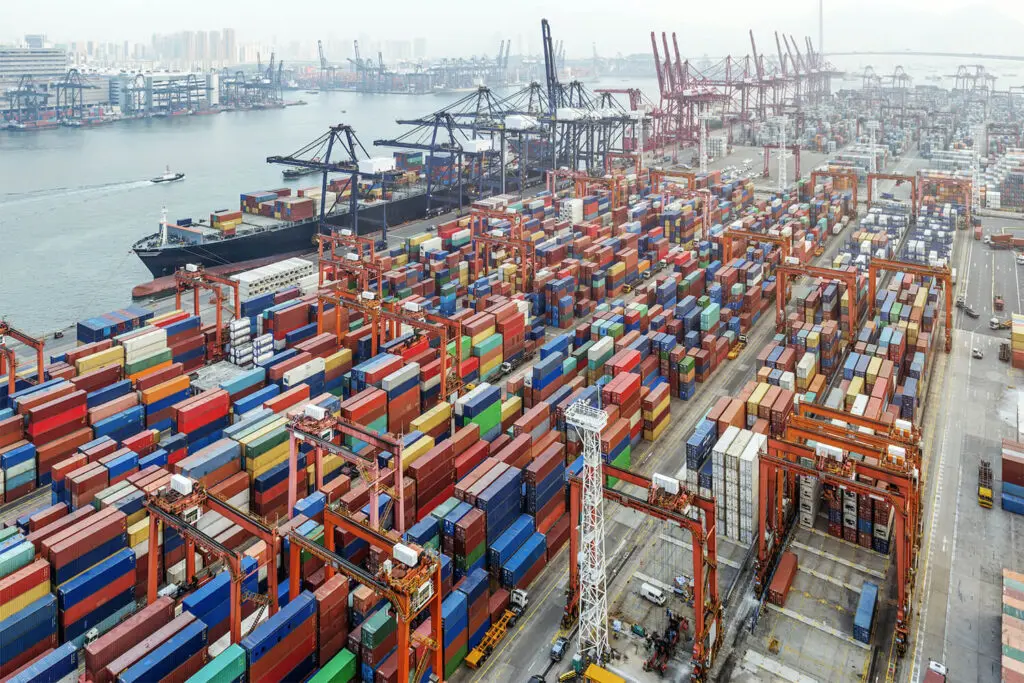Traffic jams

At the beginning of 2020, the Covid-19 health crisis challenged our transversal and connected vision of the world, and revealed the fragility of local economies in the face of global logistical dysfunction. In the midst of the pandemic, the clumsy maneuvering of a container ship’s crew in the face of a sandstorm in the Suez Canal was enough to bring world trade to a halt and to confirm what the health crisis had just exposed: the extreme vulnerability of many Western value chains to the bottlenecks that a few major strategic routes can constitute.
After an initial phase of breakdown in supply, the disruption of the supply chain continued with the hike in air and sea freight rates linked to a shortage of capacity, port congestion due to the accelerated economic recovery, lack of truck drivers and epidemic outbreaks around the world. Will this episode remain a contingent event or should we expect profound changes in global logistics, with long-term transformations of business models and the rise of proximity value chains?
To gain a better grasp of the impact of these logistics upheavals, and the long-term changes they provoke, in the newsletter we have chosen to invite three executives from our shareholdings to a cross-interview: Mr. Laurent Cayet, CEO of the IMX group, and Mr. Tarek Ghandour and Mr. Sylvain Picke, respectively CEO and Director of Supply and Purchasing of the Retif group.
Supply chain cross-interview

Laurent Cayet – CEO, IMX

Tarek Ghandour, PDG de Retif

Sylvain Picke, Director of Supply and Purchasing of the Retif Group
How has your supply chain been impacted during and following the Covid-19 crisis by (i) the global shortage of sea containers, (ii) new logistics issues (closure of delivery points, port congestion, etc.), (iii) the rise in raw material prices?
Laurent Cayet:We were mainly impacted by the sudden halt in domestic and international flights, and then by the unpredictable partial re-openings and temporary closures. Indeed, a large part of the flow of mail and small e-commerce packages is carried in the holds of tourist flights. We were therefore faced with a capacity shortage. Initially, we had to close routes, store our customers’ flows, extend delivery times, etc.
The airlines gradually introduced cargo flights, but the impact is still being felt in terms of capacity and therefore in terms of purchase prices. We have still not returned to pre-covid rates, and we have little visibility on a return to normal; personally, I don’t think this will happen by early 2022. Indeed, the rates have doubled on air transport, and the weight of transport in the cost structure has therefore exploded. For a 20g letter, this has little impact, but for a 3kg parcel, it changes the situation.
Concerning delivery times, they are still extended on certain destinations. The impact is much weaker towards or from Europe, where transport is done mostly by truck.
On the other hand, we are only slightly affected by the supply of raw materials, except for cardboard boxes and pallets, whose prices have increased by 15% since the beginning of the year. But this is not a major factor in our cost structure.
Tarek Ghandour, Sylvain Picke: We have been impacted both by the shortage of raw materials and by the problems linked to sea freight, as part of our products are sourced from Asia.
On the near import side, the shortage of raw materials has caused both supply problems upstream, with about 20% disruption in the spring, and significant price increases of around 20% or 25%.
For distant imports, we suffered from the sharp inflation in freight rates and had to urgently relocate our sourcing.
How were the changes in costs passed on to your customers?
Laurent Cayet : During the first phase of the Covid-19 crisis, it was difficult for us to pass on rate increases to customers. We did so when we had no choice, mainly for customers with whom our margins were already tight. The reason for this non-passing on or very partial passing on is the complexity of management. Indeed, the tariffs were changing every day, and it was difficult for us to adapt them on a daily basis. Moreover, La Poste, which remains the French reference for the delivery of mail and small parcels, did not increase its rates at all in 2020, and only slightly in 2021. In order not to lose business, we could not pass on these increases as we wished.
Tarek Ghandour, Sylvain Picke : In terms of costs, we are subjected to the steep rise in freight rates as well as the increase in the cost of raw materials, which is being passed on in part by our suppliers. As we are unable to pass on these increases as we would like, we have created two separate monitoring systems: the first one monitors the actual and announced price increases of our suppliers on a day-to-day basis, and the second one allows us to monitor the price increases of our competitors, product line by product line.
We have only been able to pass on part of the supplier price increases, by aligning ourselves with our competitors’ pricing policy. In addition, we are regularly the only player to have significant inventories, which allows us to reduce the sensitivity of our prices to inflation.
What opportunities are presented by this disruption of the global supply chain? Could this lead to fundamental changes in your business model or do you envisage a return to the pre-covid situation?
Laurent Cayet : Apart from the fact that the crisis boosted e-commerce due to lockdowns and closure of stores, new delivery methods have emerged, such as ship-to-store and ship-from-store.
The advantages of ship-from-store are numerous: there is less distance and therefore less pollution than sending from e-commerce warehouses, it makes it possible to enlarge the range of products available online with products sometimes only available in stores, to clear the stock of stores, to avoid cancelling online orders because of a sudden shortage in the main stock when the product may be available in store, etc. This mode of delivery has greatly increased during the covid crisis. It is a potential threat for us because it is a flow that is no longer transported from France to another country. It is also an opportunity because we offer these services to our customers to spare them the management of carriers in each country. It is still quite marginal in our flows but we have made it a flagship project in the company, because in my opinion, it is not an epiphenomenon but an important axis of development.
Tarek Ghandour, Sylvain Picke : In order to deal with the problems of the breakdown of the global supply chain and the rising cost of raw materials, we quickly created a multi-sector working group to take measures very quickly to control our supplies. We focused our needs on the most popular products in our catalog for each category, and on alternative solutions for our customers, to allow each of our suppliers to focus on a limited number of products. In this way, we organized a sales shift, which allowed us to reduce the breadth of our product range and minimize the impact of current sourcing issues.
Delivery times have also increased, both for near import and Asia. We have responded to this by increasing our inventory, which is currently larger than that of our competitors. At the same time, we have educated our customers to choose alternatives to their initial choices, which provides us with strong growth and a competitive advantage: customers come to us because we have stock and can respond quickly to their needs.
In the future, we will return to an extremely wide range of products, but we will keep monitoring prices very closely.
In the medium to long term, this crisis will reshuffle the cards in sourcing. With the explosion of sea freight rates from China, sourcing from Asia is no longer necessarily a source of savings. And this paradigm shift is likely to continue post-crisis, according to freight forwarders. This changes the game in terms of cost prices and creates opportunities to reconsider supply areas. In the medium term, we will therefore reduce Asian sourcing in favor of more regional sourcing (Eastern and Southern Europe).
The crisis has also shown customers the value of wholesalers, who provide buffer stocks and therefore allow small professionals to cope in the event of a shortage without incurring the costs of an intermediate stock.
Finally, I believe that this crisis will lead to changes in customer behavior. The market will absorb several tens of points of increase. The customer will have to adapt, and there is real uncertainty about what this adaptation will lead to (increased demand for entry-level products, reduced demand, technological developments, etc.). The real issue for the next few years will be understanding these changes in order to adapt to them as quickly as possible.